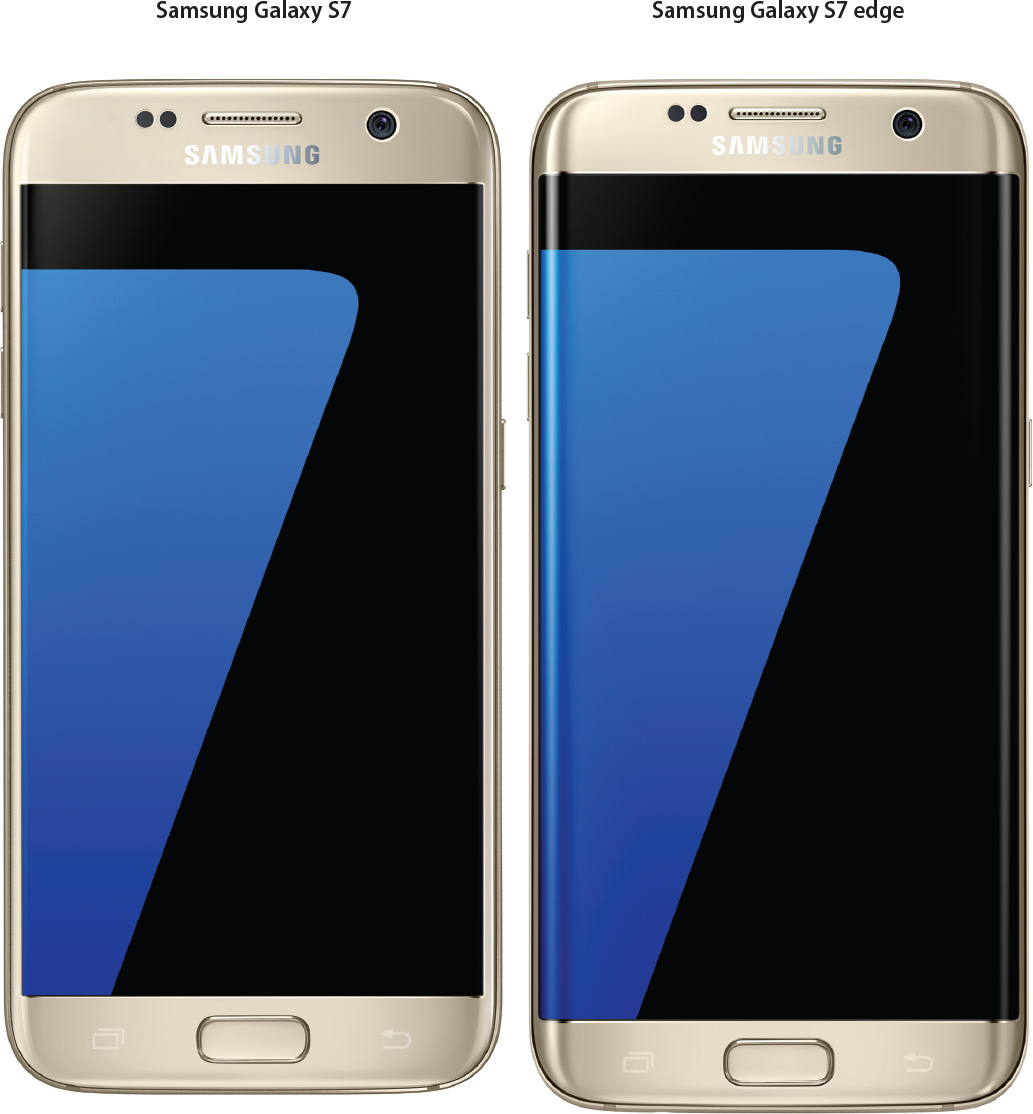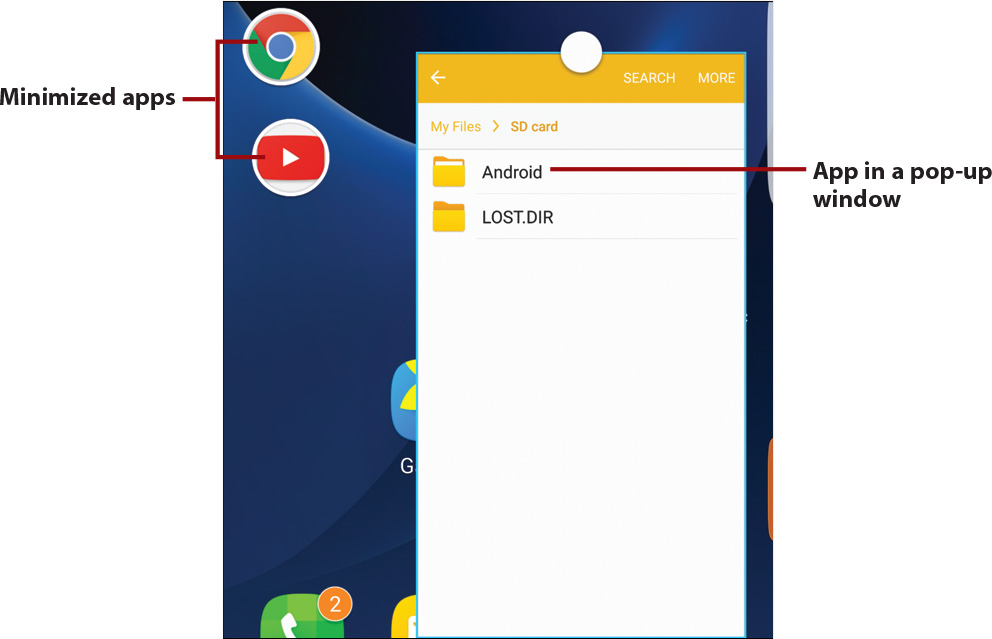Prologue: Getting to Know Your Galaxy S7
In this chapter, you become familiar with the external features of the Galaxy S7 and the basics of getting started with the Android operating system. Topics include the following:
![]() Getting to know your Galaxy S7’s external features
Getting to know your Galaxy S7’s external features
![]() Learning gestures and motions
Learning gestures and motions
![]() Setting up your Galaxy S7 for the first time
Setting up your Galaxy S7 for the first time
![]() Learning the fundamentals of Android 6.01 (Marshmallow) and TouchWiz
Learning the fundamentals of Android 6.01 (Marshmallow) and TouchWiz
![]() Installing desktop synchronization software
Installing desktop synchronization software
Before you start customizing your Galaxy S7 and working with apps, you should examine the external features, device features, and the Android 6.01 operating system.
In addition to Android 6.01 (Marshmallow), this chapter covers the Samsung TouchWiz interface, which is overlaid on top of Android to adjust the way things look and function.
Your Galaxy S7’s External Features
Becoming familiar with the external features of your Galaxy S7 is a good place to start because you will be using them often. This section covers some of the technical specifications of your Galaxy S7, including the touchscreen and camera. There are two versions of the Samsung Galaxy S7: the S7 and the S7 edge. With the exception of a few extra features provided by the curved screen on the S7 edge, the functionality and look and feel of the interface on the two phones are exactly the same.
Getting to Know Your Galaxy S7
Front

• Proximity/gesture sensor—Detects when you place your Galaxy S7 against your head to talk, which causes it to turn off the screen so that your ear doesn’t inadvertently activate any onscreen items. This sensor also allows you to use gestures (in conjunction with the accelerometer). Gestures are covered later in the Prologue.
• Light sensor—Adjusts the brightness of your Galaxy S7’s screen based on the brightness of the ambient light.
• Earpiece—The part you hold against your ear while on a call.
• Indicator light—Indicates new events (such as missed calls, new Facebook messages, and new emails). This indicator light is invisible until it illuminates.
• Front camera—A 5.0-megapixel front-facing camera that you use for video chat, taking self-portraits, and even unlocking your Galaxy S7 using your face.
• Touchscreen—On the Galaxy S7, a 5.1″ 1440×2560 pixel Quad HD Super AMOLED (Super Active-Matrix Organic Light-Emitting Diode) screen that incorporates capacitive touch. On the Galaxy S7 edge, a 5.5″ 1440×2560 pixel Quad HD Super AMOLED (Super Active-Matrix Organic Light-Emitting Diode), dual-edge screen that incorporates capacitive touch.
• Back button—Takes you back one screen when you’re using an application or menu. This is a touch-sensitive button.
• Recent Apps button—Shows you a list of apps you recently used. You can then touch to jump to them or swipe them off the screen to close them. Touch and hold to see additional options for the current screen. The Recent Apps button replaces the Menu button on previous Galaxy S series phones.
• Home button/fingerprint reader—Takes you to the Home screen. The application that you are using continues to run in the background. Press twice to launch the Camera app. Press and hold to launch Google Now. A fingerprint reader is built in to the Home button; you can read more about it in Chapter 1, “Making the S7 Your Own.”
Back
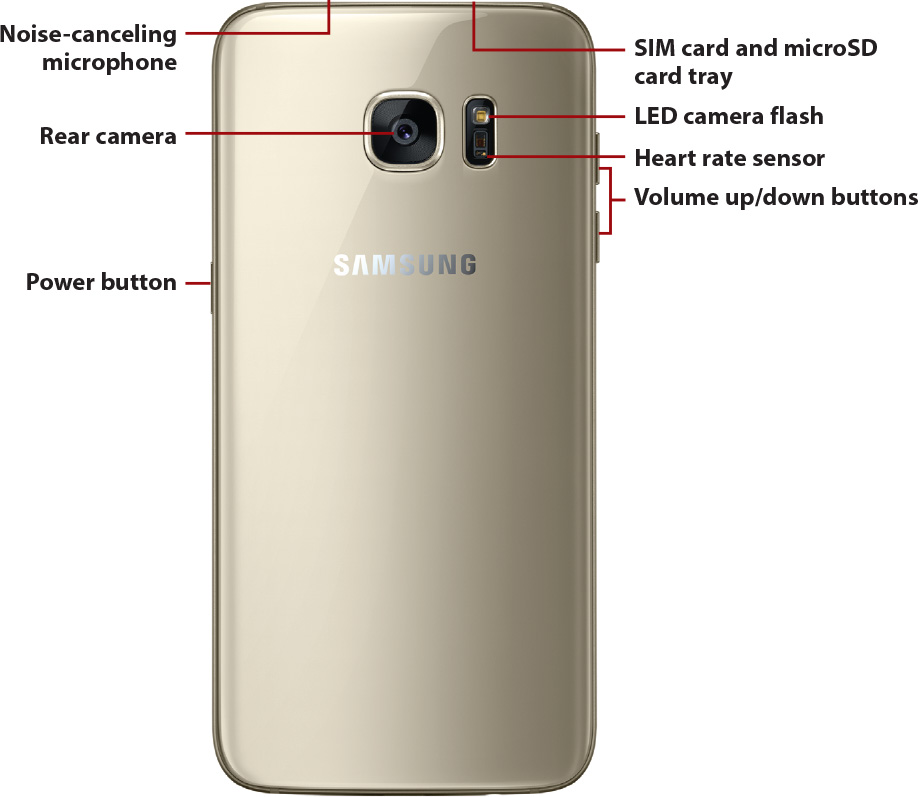
• Volume up/down buttons—Enable you to control the audio volume on calls and while playing audio and video.
• Power button—Allows you to wake up your Galaxy S7 by pressing once. Press and hold for one second to reveal a menu of choices. The choices enable you to power off your S7, restart your S7, or put it into Emergency mode. In Emergency mode, your S7 greatly reduces battery usage and starts reporting its location to a chosen contact.
• Rear camera—A 12-megapixel camera with autofocus and Optical Image Stabilization (OIS) that takes clear pictures close up or far away.
• LED (light-emitting diode) camera flash—Helps to illuminate the surroundings when you’re taking pictures in low light.
• Heart rate sensor—While using the S Health app, place your finger over the heart rate sensor to allow S Health to detect your heart rate.
• SIM card and microSD card tray—Use the SIM card tray ejection tool provided in the box to eject the SIM card tray and insert a new or replacement SIM card. The SIM card tray also includes a place to insert a microSD memory card. This allows you to expand the memory on your S7 up to 200 Gigabytes.
• Noise-canceling microphone—Use in conjunction with the regular microphone to reduce background noise during phone calls. This microphone is also used when you record videos.
Bottom
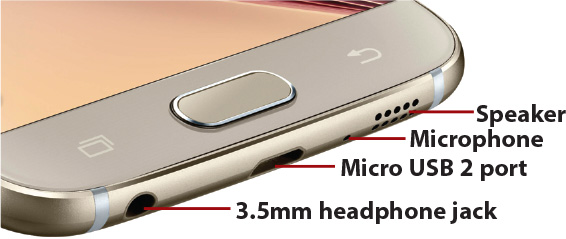
• Micro USB 2 port—You can use the Micro USB 2 port to synchronize your Galaxy S7 to your desktop computer and charge it.
• Microphone—You use the microphone when you are on a call and holding your Galaxy S7 to your ear.
• Speaker—The speaker is used when you use the speakerphone function while on a phone call, and it is also used to play all audio, including notifications, music, and audio from videos.
• 3.5mm headphone jack—Plug in your Galaxy S7 or third-party headset to enjoy music and talk on the phone.
Gestures and Motions
Gestures and motions allow you to quickly use certain functions or features by making hand gestures or moving the S7 in a specific way.
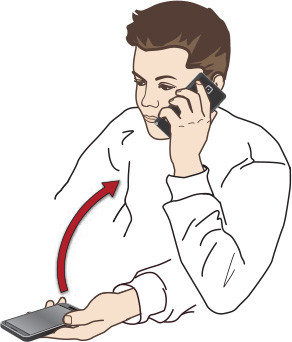
• Direct Call—While you are looking at a missed call, reading an SMS (text message) from someone, or viewing someone’s contact information, you can lift your S7 to your ear and hold it there to dial the phone number being viewed.

• Smart Alert—If you have missed calls or messages, when you pick up your S7 from a flat surface, it vibrates.
• Easy Mute—To mute incoming calls and alarms, either place your hand over the screen or turn your S7 over.
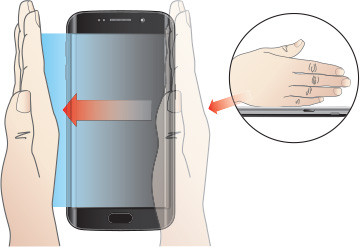
• Palm Swipe to Capture—You can capture a screenshot by holding your palm perpendicular to the screen, touching it on the screen and swiping it from left to right or right to left. The captured screenshot goes to the Screenshots album, which you can view using the Gallery or Photos app.
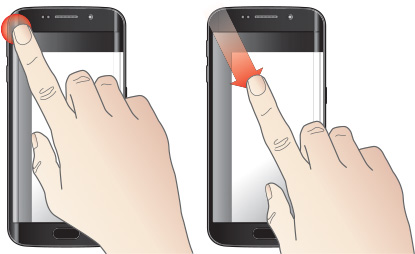
• Pop-up View—Swipe diagonally down from the top-left of the screen to make the app you are using switch the Pop-up view where it reduces in size to a smaller on-screen window. Read more about Pop-up view later in this Prologue in the “Run Multiple Apps on the Screen at the Same Time” section.
First-Time Setup
Before setting up your new Samsung Galaxy S7, you should have a Google account because your Galaxy S7 running Android is tightly integrated with Google. When you have a Google account, you can store your content—including any books and music you buy or movies you rent—in the Google cloud. If you do not already have a Google account, go to https://accounts.google.com on your desktop computer and sign up for one.
1. Press and hold the Power button until you see the animation start playing (not shown).
2. Tap to change your language if needed.
3. Tap Start to continue.
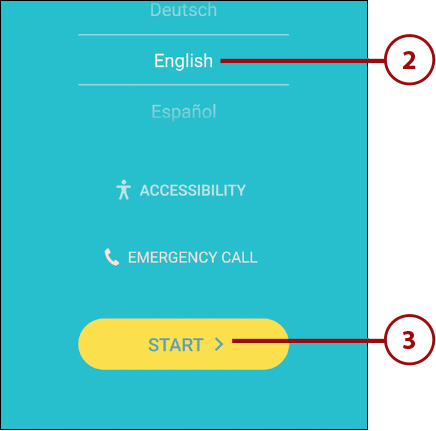
4. Tap a Wi-Fi network you want to connect to during setup. If you’d rather not connect to a Wi-Fi network, tap Next and continue at step 8.
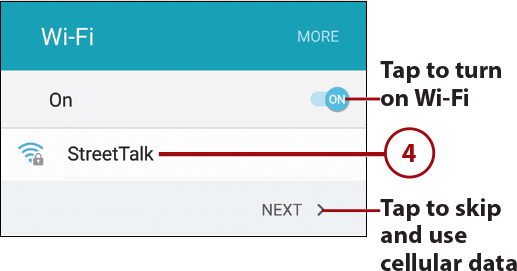
Why Use Wi-Fi During Setup?
As you go through the first-time setup of your S7, you may choose to restore a backup of a previous device to your S7, and at the end of the device setup, a number of apps may need to be updated. Both of these activities can use a lot of data. Using Wi-Fi speeds up these activities as well as saves you the cost of the cellular data charges. Although you do not have to connect to a Wi-Fi network for device setup, it is advisable.
5. Enter the password for the Wi-Fi network using the onscreen keyboard.
6. Tap Connect. Your Galaxy S7 connects to the Wi-Fi network.
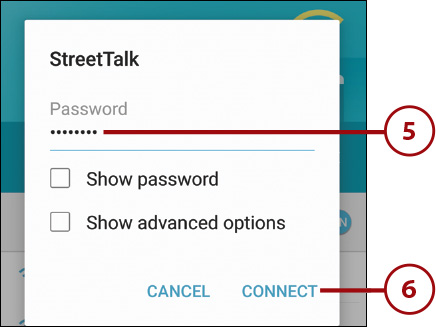
7. Tap Next.
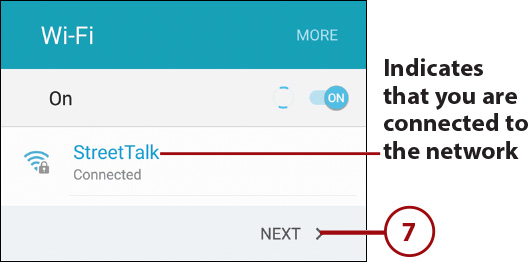
8. Check the box to allow Samsung to collect diagnostic and usage data from your S7.
9. Tap Next.

10. Tap Agree after you have read and understood the End User License Agreement (EULA).
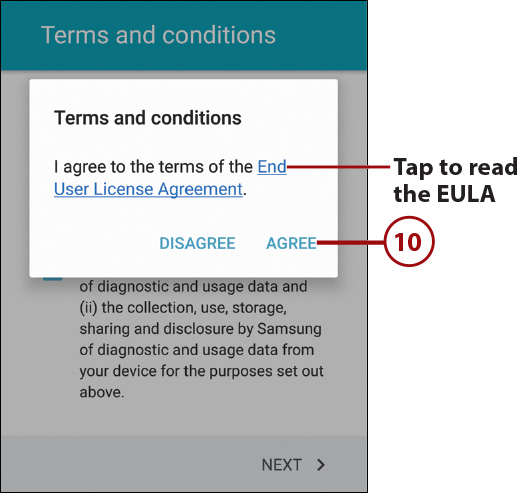
11. If you have another Android device (tablet or smartphone) running Android 5.0 (Lollipop) or later, and you want to transfer the data from it to your new phone, select Copy your Google Accounts, apps, and data from another device, tap Next, and follow the instructions on the following screens, or select No thanks, and tap Next to continue.
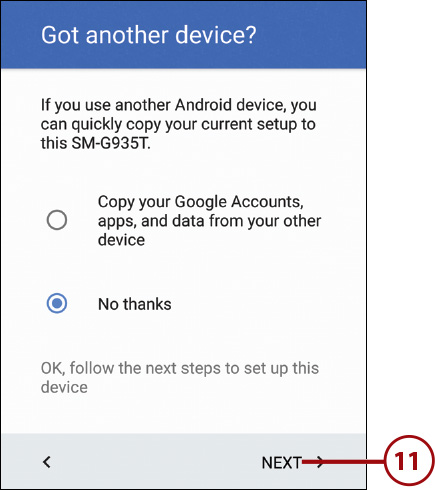
12. Enter your Google account email address (your Gmail address).
13. Tap Next.
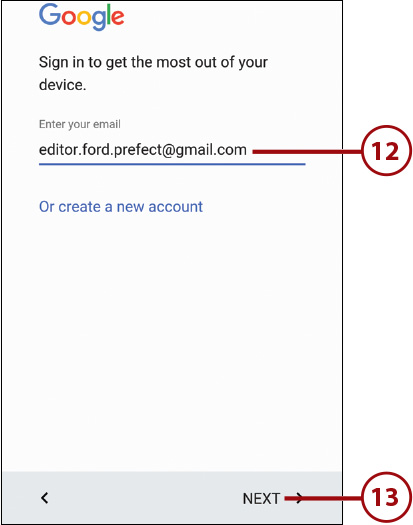
14. Enter your Google account password.
15. Tap Next to continue.
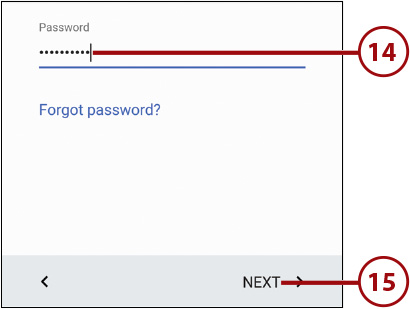
16. Tap Accept to continue.
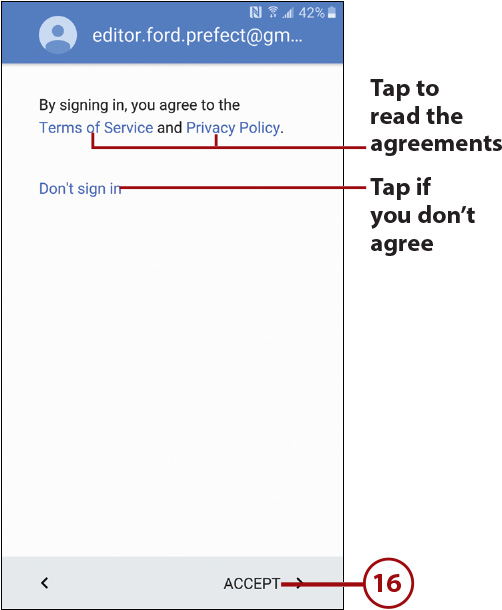
17. Check this box if you want to back up your phone’s data so that it can be restored to a new Android phone or smartphone in the future.
18. Check this box if you are okay with Google collecting information about your geographic location at any time. Although Google keeps this information safe, if you are concerned about privacy rights, you should uncheck this box.
19. Check this box if you are okay with your phone scanning for Wi-Fi networks even if you have the Wi-Fi radio turned off. This helps improve location accuracy.
20. Tap Next to continue.
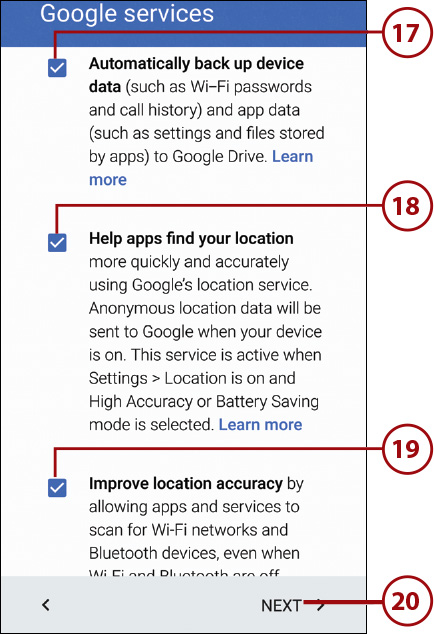
21. Select Not Now. Chapter 6, “Email and Text Messages,” covers adding IMAP and POP accounts.
22. Tap Next.
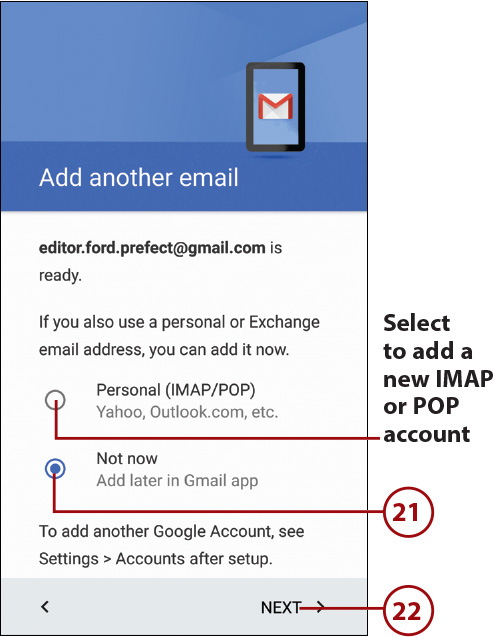
23. Tap Set Up Fingerprint. If you choose not to set any phone protection (not recommended), tap No Thanks, and skip to step 32.
24. Tap Next.
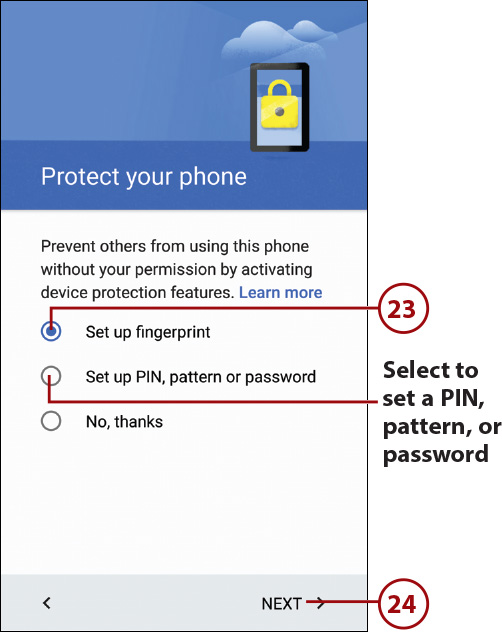
25. Tap PIN to choose to use a numeric PIN as your fingerprint backup unlock method. This example uses a PIN; however, you can choose to use a pattern or password as your fingerprint backup unlock method.
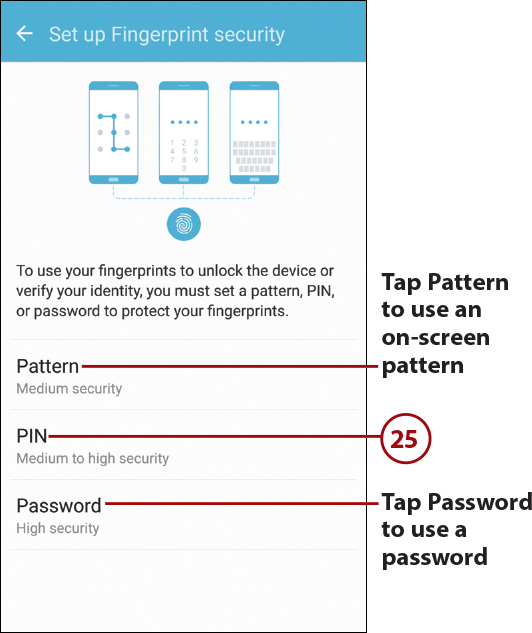
Why Must I Use a PIN, Pattern, or Password When Choosing Fingerprint?
When you choose to use your fingerprint to unlock your Galaxy S7, you must first choose a backup unlock method. This method is used as the only method of unlocking your S7 after you restart it, or if your fingerprint cannot be read by the fingerprint sensor.
26. Enter a numeric PIN and tap Continue.
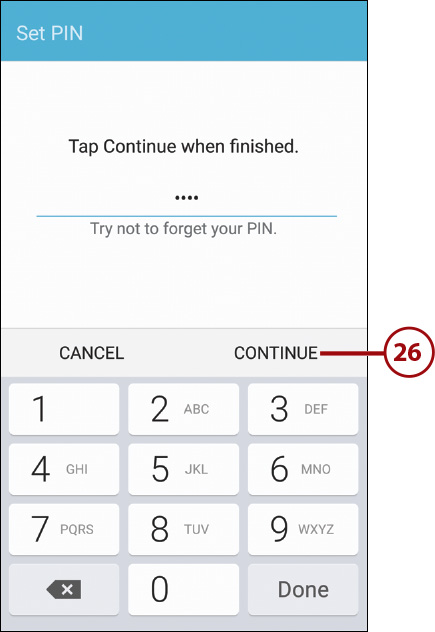
27. Re-enter the same numeric PIN and tap OK.
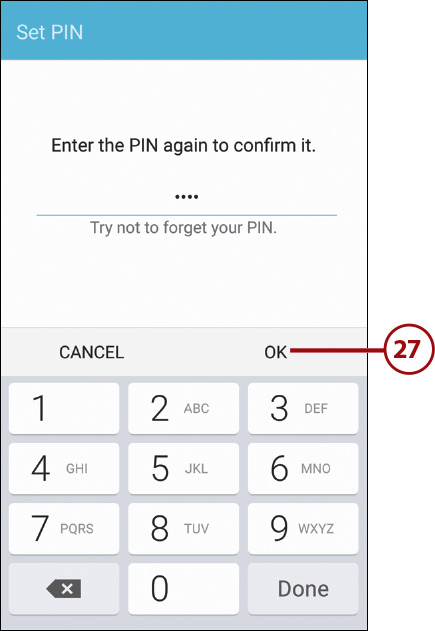
28. Follow the on-screen instructions that walk you through placing your finger on the Home key and then lifting it off the Home key repeatedly until your S7 has fully captured your fingerprint.

29. Choose whether you want notifications to be displayed on the Lock screen while your phone is locked. You can choose to show notifications and their content, notifications with no content, or to hide all notifications.
30. Tap Done.
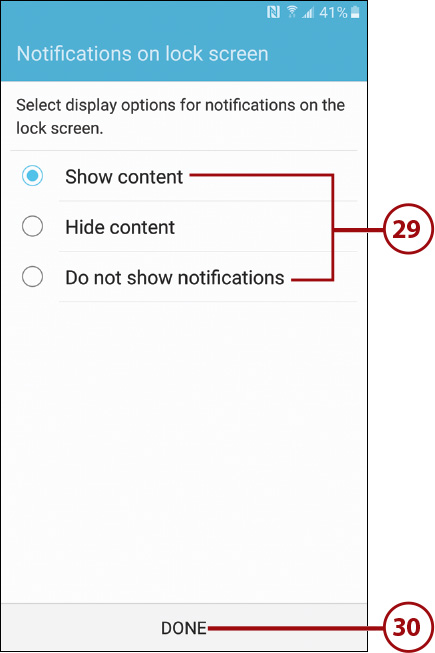
31. Tap Next on the screen lock confirmation screen (not shown).
32. Enter the email address you used for your Samsung account.
33. Enter your Samsung account password.
34. Tap Sign In.
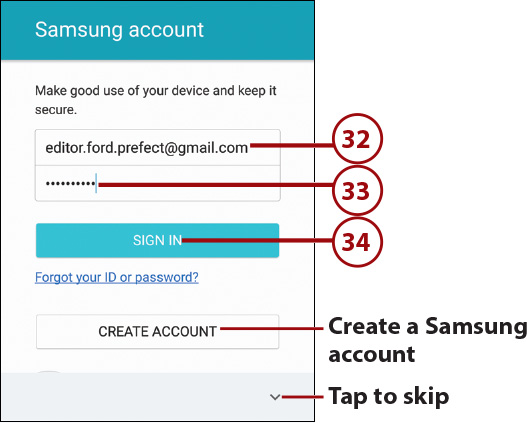
35. Move the slider to on to enable automatically backing up your data to your Samsung account.
36. Tap Later. For this example we are not restoring a backup from a previous Samsung device. However, if you would rather restore a backup, tap Next and follow the steps, then continue at step 37.

37. Tap to turn the switch on if you want your S7 to use Easy mode. Easy mode uses a simplified Home screen layout and enlarges the text and size of the app icons. You can always disable Easy mode later if you decide it’s not for you.
38. Tap Finish to complete your S7’s setup. Depending on the wireless provider you are using, after you finish the device setup, you may see some extra screens that are specific to your wireless provider.
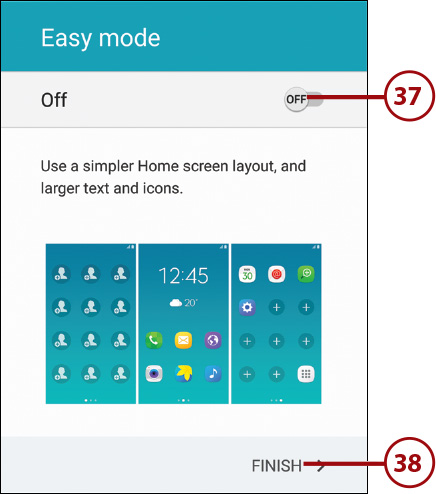
Fundamentals of Android 6.01 and TouchWiz
Your Galaxy S7 is run by an operating system called Android. Android was created by Google to run on any smartphone, and your Galaxy S7 uses a version called Android 6.01 (or Marshmallow). Samsung has made many changes to this version of Android by adding extra components and modifying many standard Android features. They call this customization TouchWiz.
The Lock Screen
If you haven’t used your Galaxy S7 for a while, the screen goes blank to conserve battery power. This task explains how to interact with the Lock screen.
1. Press the Power button or Home button to wake up your Galaxy S7 (not shown). It is better to press the Home button, especially if you are making use of the fingerprint reader to unlock your S7.
2. Slide your finger across the screen in any direction to unlock your Galaxy S7.
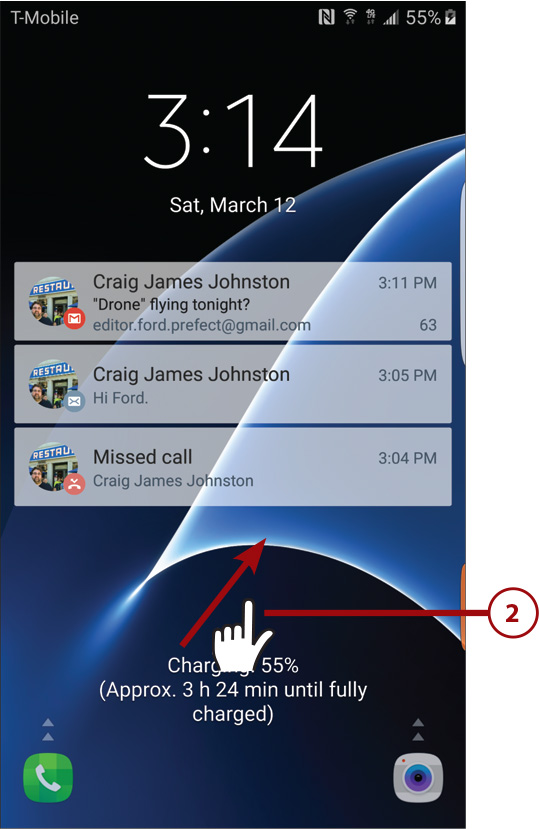
Step 2 assumes that you are using the swipe-to-unlock method of unlocking your S7, which is why we direct you to swipe the screen; however, you may have chosen to use a more secure method of locking your S7 including using a pattern, a numeric PIN, a password, or even your fingerprint. If you are using your fingerprint to unlock your S7, and just want to see the notifications on your Lock screen without actually unlocking your S7, then you should either press the Power button or press the Home button using a finger that you have not scanned with the fingerprint reader.
3. Tap a notification, such as a missed call or new email notification, and then swipe the screen to unlock and go directly to the call log or email message.
4. Swipe up from the Camera icon to launch the Camera.
5. Swipe up from the Phone icon to launch the Phone.
6. Swipe the notifications down if you want to see more of them.
7. Swipe the notifications left or right to dismiss them.
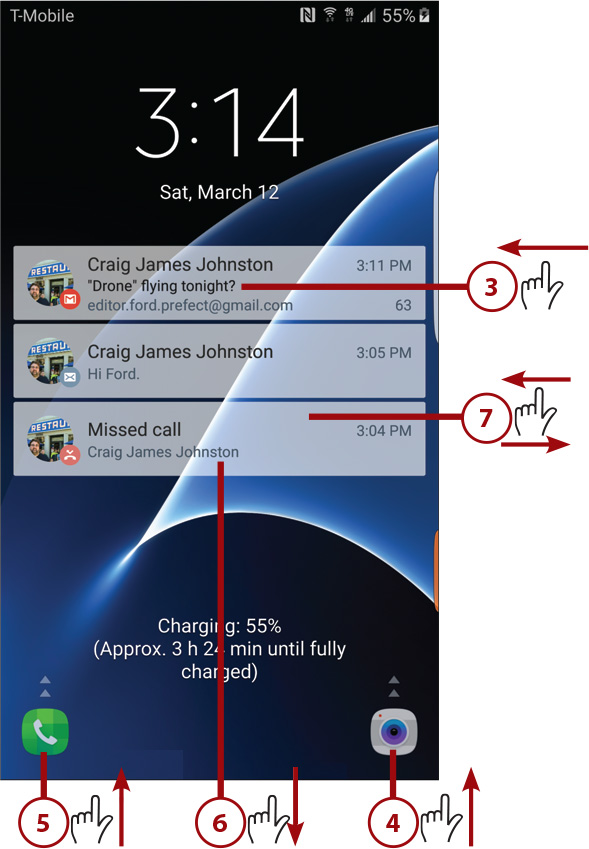
Working with Settings on the Lock Screen
You can work with settings right on the Lock screen. Swipe down from the top of the screen to show the Quick Settings. You see the Quick Settings plus any notifications. Tap Clear to clear all notifications.
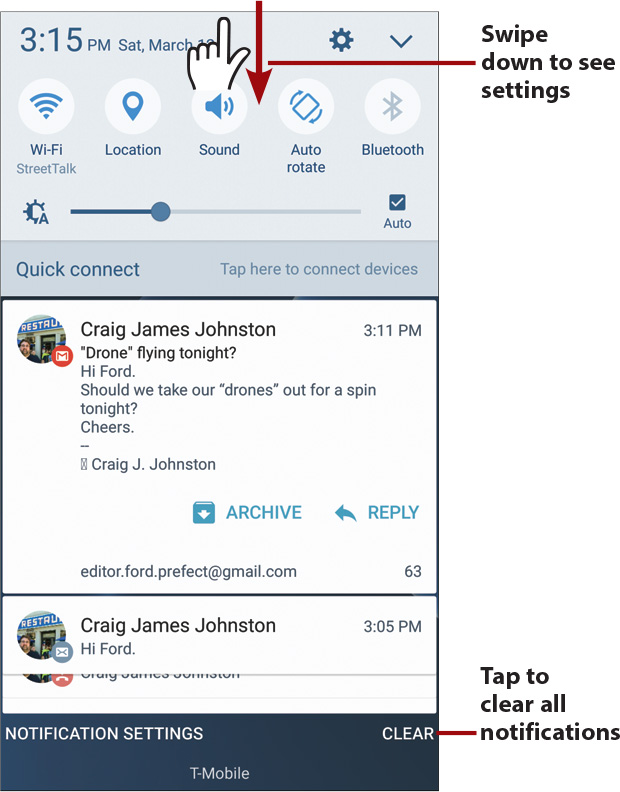
Answering a Call from the Lock Screen
If your Galaxy S7 is locked when a call comes in, you have three choices: Drag the green icon to the right to answer the incoming call; drag the red icon to the left to reject the incoming call and send it straight to voicemail; or drag up from the bottom of the screen to reject the call and send a preset text message (SMS) to the caller.
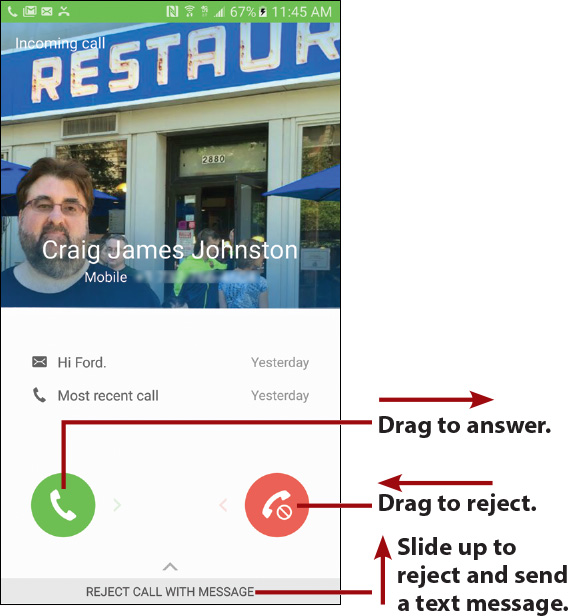
The Home Screen
After you unlock your Galaxy S7, you are presented with the Home screen. Your Galaxy S7 has four Home screen panes (although you can create more). The Home screen panes contain application shortcuts, a Launcher icon, Notification bar, Shortcuts, Favorites Tray, and widgets.
• Notification bar—The Notification bar shows information about Bluetooth, Wi-Fi, and cellular coverage, as well as the battery level and time. The Notification bar also serves as a place where apps can alert or notify you using notification icons.
• Notification icons—Notification icons appear in the Notification bar when an app needs to alert or notify you of something. For example, the Phone app can show the Missed Calls icon, indicating that you missed a call.
• Widgets—Widgets are applications that run directly on the Home screens. They are specially designed to provide functionality and real-time information. An example of a widget is one that shows the current weather or provides a search capability. Widgets can be moved and sometimes resized.
• App shortcut—When you tap an app shortcut, the associated app launches.
• App folders—You can group apps together in a folder as a way to organize your apps and declutter your screen.
• Favorites Tray—The Favorites Tray is visible on all Home screen panes. You can drag apps to the Favorites Tray so that they are available no matter which Home screen pane you are looking at. You can rearrange or remove apps in the Favorites Tray.
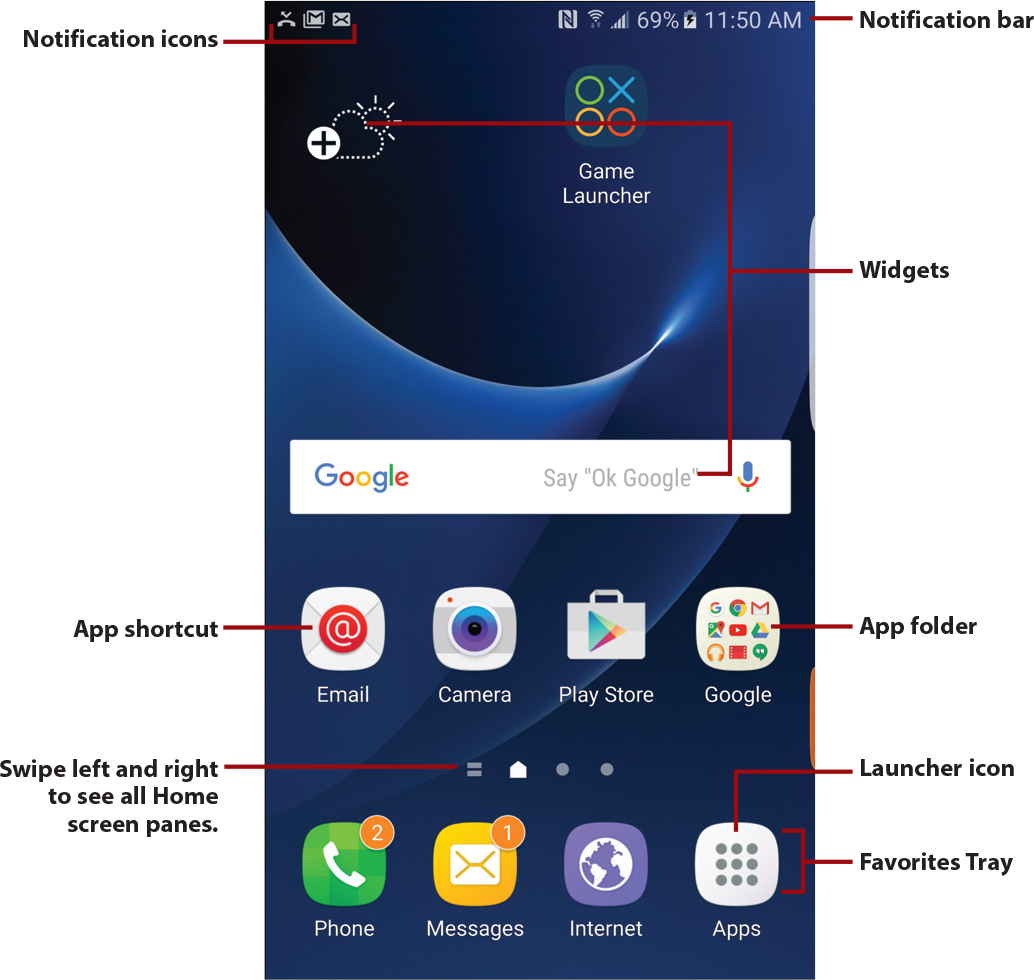
• Launcher icon—Tap to show application icons for all applications that you have installed on your Galaxy S7.
The Special Home Screen Pane: Flipboard Briefing
If you swipe all the way to the left-most Home screen pane, you see the Flipboard app’s Briefing view. The Flipboard app is a portal for news including business, technology, celebrity, science, entertainment, style, food, and travel. Your S7 provides you with the Flipboard app’s Briefing view. Scroll up and down to see all news feeds. Tap the Menu icon to customize each news topic, rearrange the topic layout, and install the full Flipboard app. Swipe left to return to the first Home screen pane.
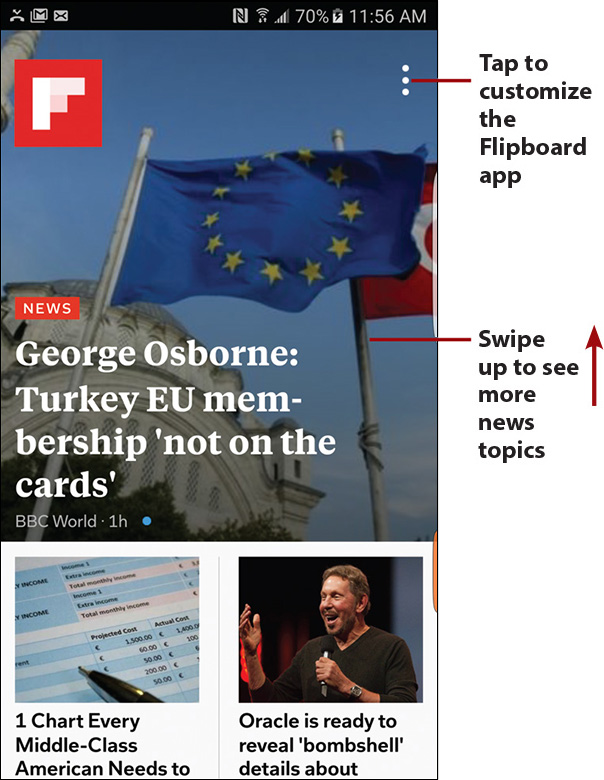
Work with Notifications
To interact with notifications that appear in the Notification bar, place your finger above the top of the screen and drag to pull down the Notification bar and reveal the notifications. Swipe individual notifications off the screen to the left or right to clear them one by one, or tap Clear to clear all of them at once. The Notification bar also includes Quick Settings, such as the ability to turn on or off Wi-Fi or Bluetooth.
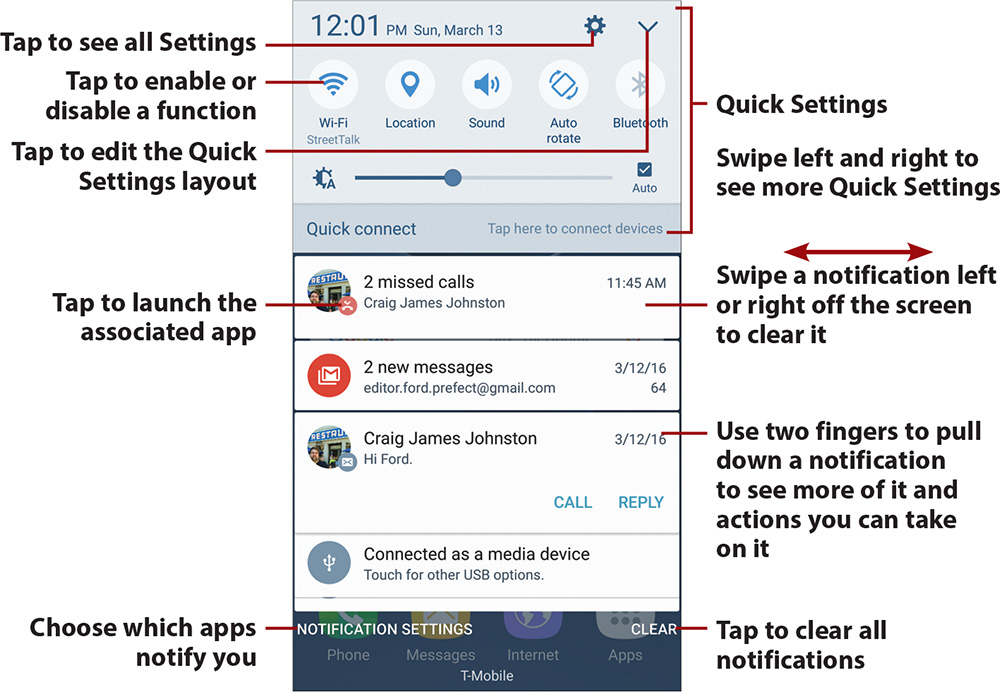
What Are Quick Settings?
Quick Settings are icons that allow quick on/off actions. Examples are turning Wi-Fi on or off and turning Bluetooth on or off. To change the settings of a particular function, touch and hold on the icon for that function. Tapping the down arrow enables you to see all of the possible Quick Settings icons, rearrange the Quick Settings icon positions, and choose which icons are visible.
Create App Shortcuts
Tap the Launcher icon to see all of your apps. (Refer to the figure in “The Home Screen” section for help identifying the Launcher icon.) Touch and hold on the app you want to make a shortcut for. After the Home screen appears, drag the app shortcut to the location you want the shortcut to be on the Home screen, drag it to an app folder, or drag it left or right off the screen to move between Home screen panes. Release the icon to place it.
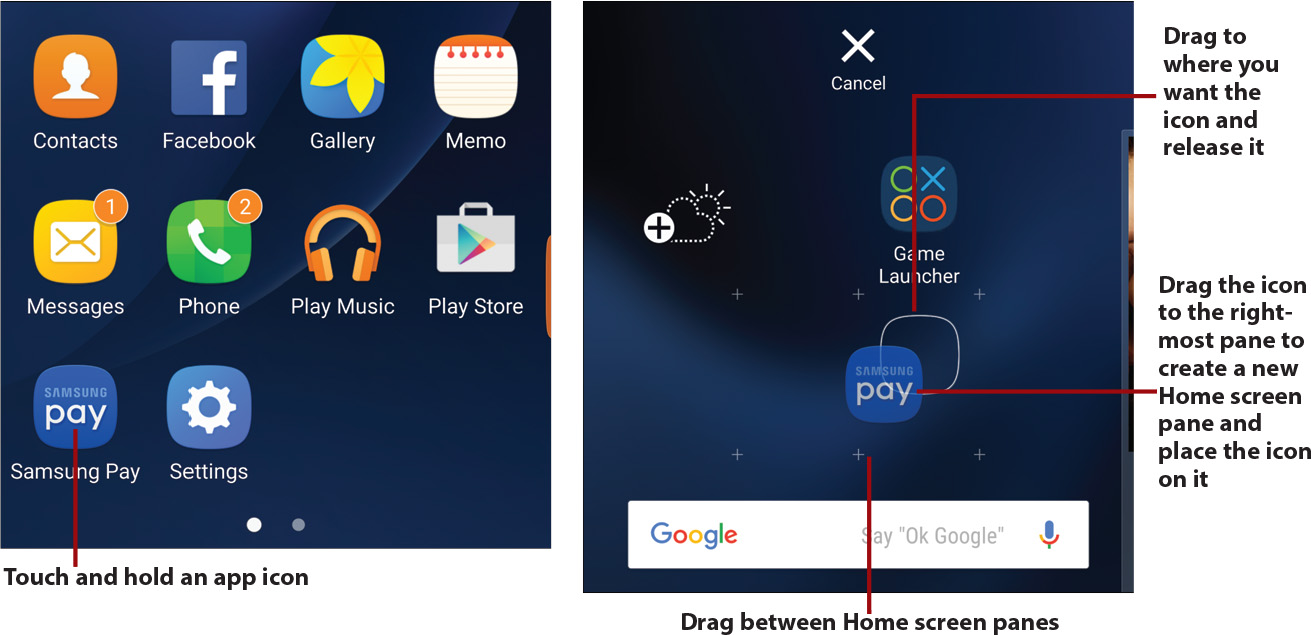
Create App Folders
To create a new app folder, touch and hold the first app shortcut you want in your folder and drag it on top of the second app shortcut you want in your folder. After you give your app folder a name, tap outside the folder to see the folder on your Home screen. Now you can drag other app shortcuts into that folder. To open the folder, tap it to reveal the shortcuts in that folder.
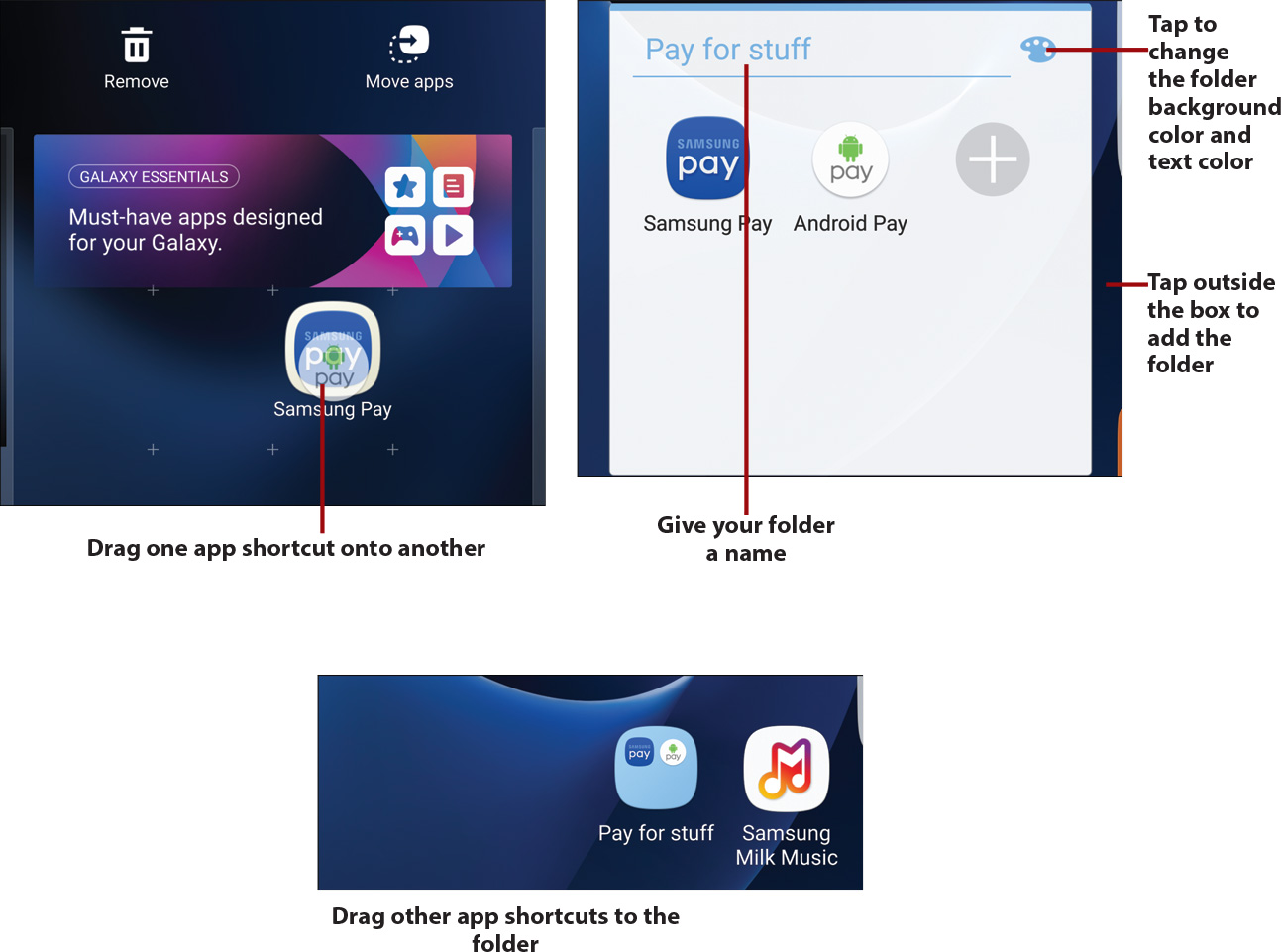
Create a New Home Screen Pane and Remove an App Shortcut
If you want to create a new Home screen pane, touch and hold an app shortcut icon. Drag your app shortcut icon to the right-most pane, and the shortcut is placed on a brand-new Home screen pane. To remove an app shortcut icon, drag it to the Remove icon.
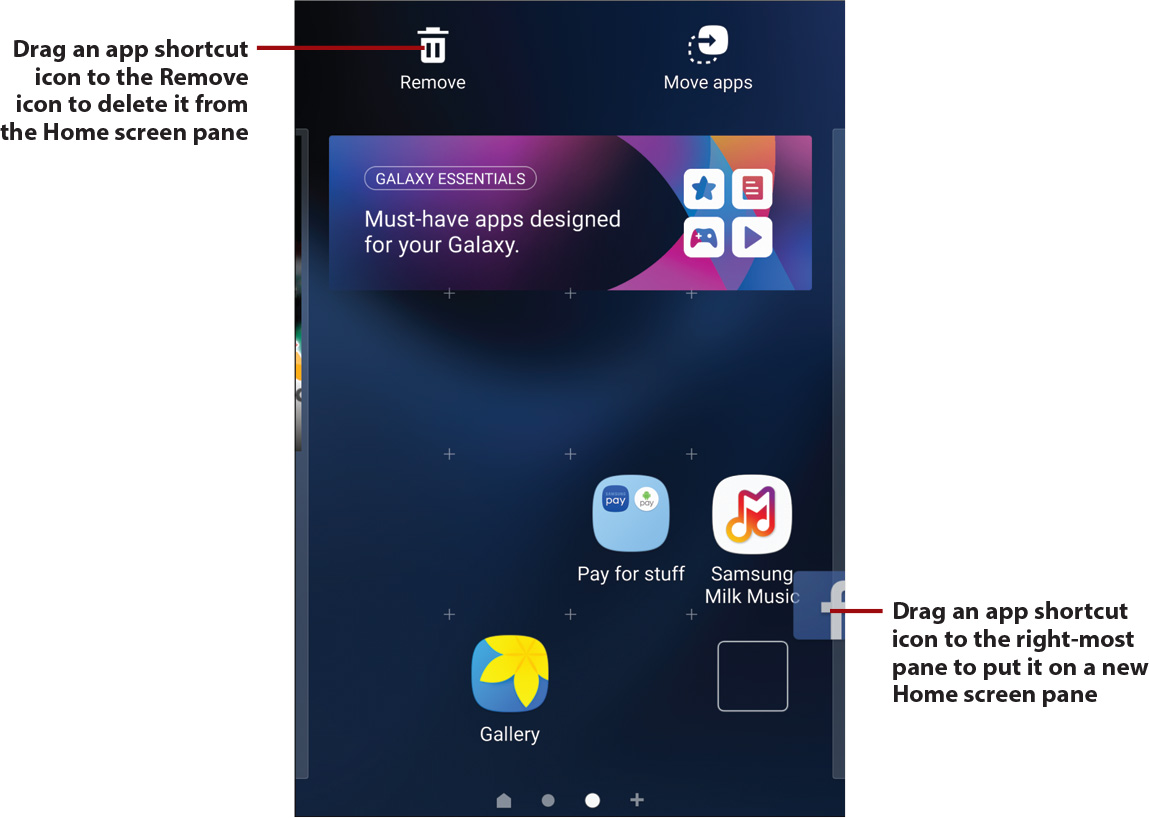
Use the Touchscreen
You interact with your Galaxy S7 mostly by touching the screen. You can tap, swipe, pinch, touch and hold, double-tap, and type.
• Tap—To start an application, tap its icon. Tap a menu item to select it. Tap the letters of the onscreen keyboard to type.

• Touch and hold—Touch and hold to interact with an object. For example, if you touch and hold a blank area of the Home screen, a menu pops up. If you touch and hold an icon, you can reposition it with your finger.

• Drag—Dragging always starts with a touch and hold. For example, if you touch the Notification bar, you can drag it down to read all of the notification messages.

• Swipe or slide—Swipe or slide the screen to scroll quickly. To swipe or slide, move your finger across the screen quickly. Be careful not to touch and hold before you swipe or you will reposition something. You can also swipe to clear notifications or close apps when viewing the recent apps.
• Double-tap—Double-tapping is like double-clicking a mouse on a desktop computer. Tap the screen twice in quick succession. For example, you can double-tap a web page to zoom in to part of that page.
• Pinch—To zoom in and out of images and pages, place your thumb and forefinger on the screen. Pinch them together to zoom out or spread them apart to zoom in (unpinching). Applications such as Browser, Gallery, and Maps support pinching.
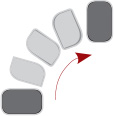
• Rotate the screen—If you rotate your Galaxy S7 from an upright position to being on its left or right side, the screen switches from portrait view to landscape view. Most applications honor the screen orientation. The Home screens and Launcher do not.
Use the Keyboard
Your Galaxy S7 has a virtual or onscreen keyboard for those times when you need to enter text. You might be a little wary of a keyboard that has no physical keys, but you will be pleasantly surprised at how well it works.
Most applications automatically show the keyboard when you need to enter text. If the keyboard does not appear, tap the area where you want to type and the keyboard slides up, ready for use.
To make the next letter you type a capital letter, tap the Shift key. To make all letters capitals (or CAPS), double-tap the Shift key to engage CAPS Lock. Tap Shift again to disengage CAPS Lock.
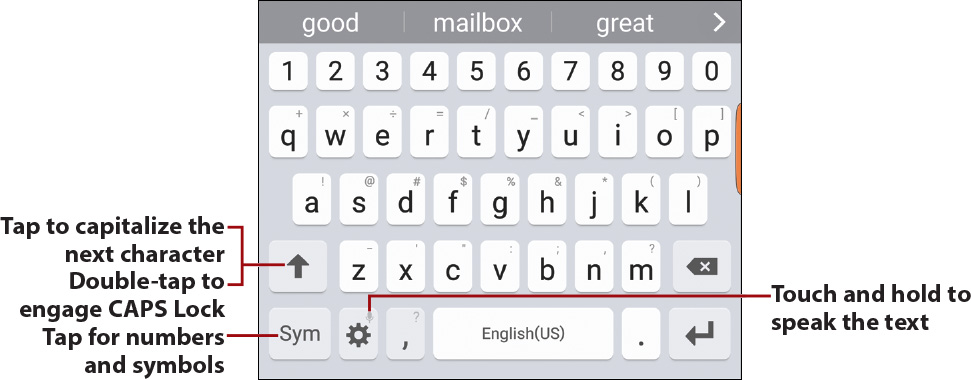
As you type, your Galaxy S7 makes word suggestions. Think of this as similar to the spell checker you would see in a word processor. Your Galaxy S7 uses a dictionary of words to guess what you are typing. If the word you were going to type is the middle option in the list of suggestions, tap space or period to select it. If you can see the word in the list but it is not the middle word, tap the word to select it.
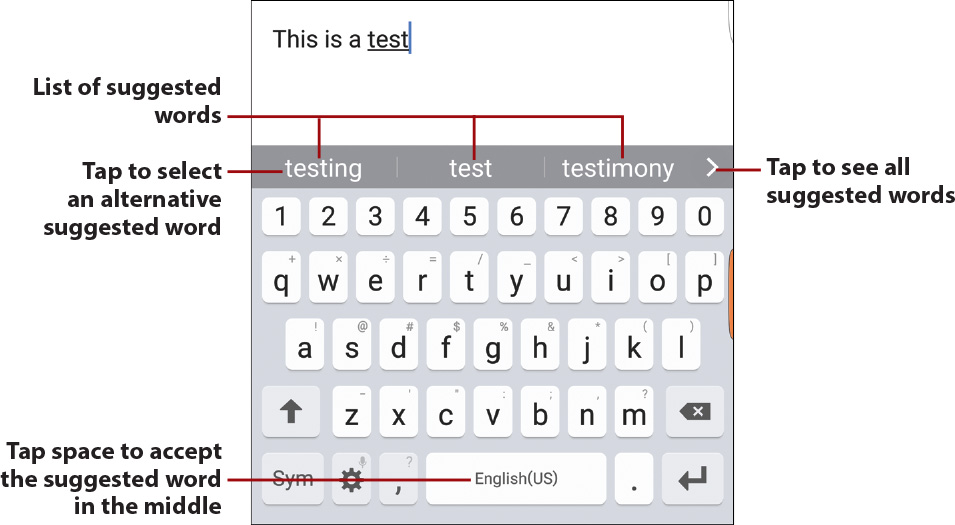
To type numbers or symbols, tap the Symbols key. When on the Numbers and Symbols screen, tap the Symbols key to see extra symbols. There are two screens of symbols. Tap the ABC key to return to the regular keyboard.
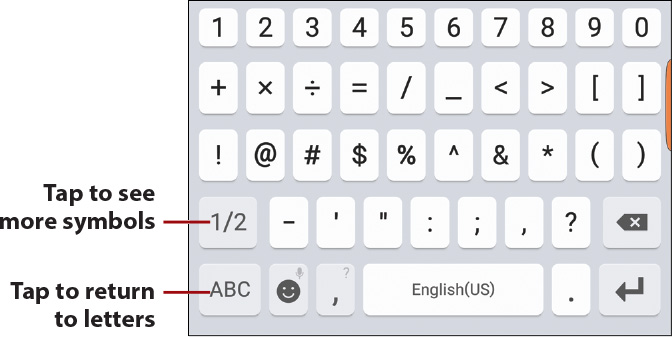
Quick Access to Symbols
If you want to type commonly used symbols, touch and hold the period key. A small window opens with those common symbols. Tap a symbol to type it.
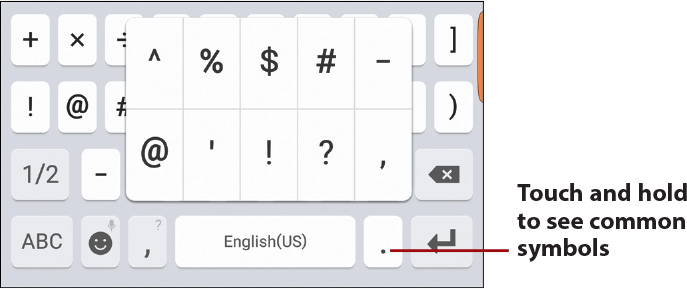
To enter an accented character, touch and hold any vowel or the C, N, or S key. A small window opens enabling you to select an accented or alternative character. Slide your finger over the accented character and lift your finger to type it.
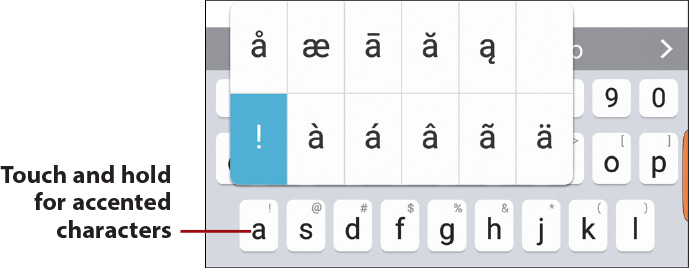
To reveal other alternative characters, touch and hold any other letter, number, or symbol.
Turn your Galaxy S7 sideways to switch to a landscape keyboard. The landscape keyboard has larger keys and is easier to type on.
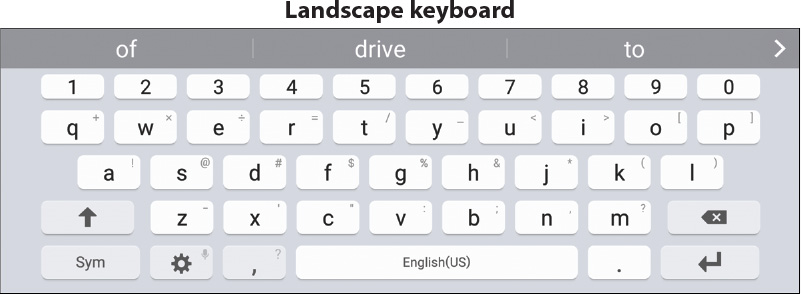
Swipe to Type
Instead of typing on the keyboard in the traditional way by tapping each letter individually, you can swipe over the letters in one continuous movement. This is called Continuous Input. It is enabled by default; to use it, just start swiping your finger over the letters of the word you want to type. Lift your finger after each word. No need to worry about spaces because your Galaxy S7 adds them for you. To type a double letter (as in the word pool), loop around that letter on the keyboard. As you swipe, a blue line trails your finger.
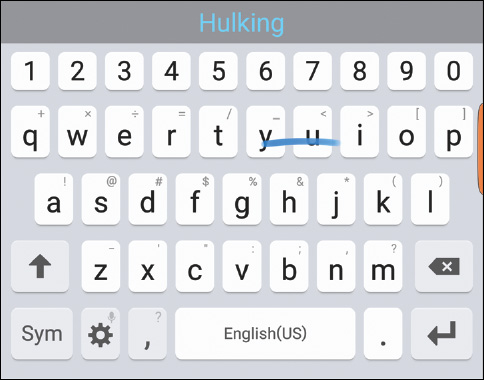
Dictation—Speak Instead of Type
Your Galaxy S7 can turn your voice into text. It uses Google’s speech recognition service, which means you must have a connection to the cellular network or a Wi-Fi network to use it.
1. Touch and hold the Settings icon.
2. Tap the Microphone icon.
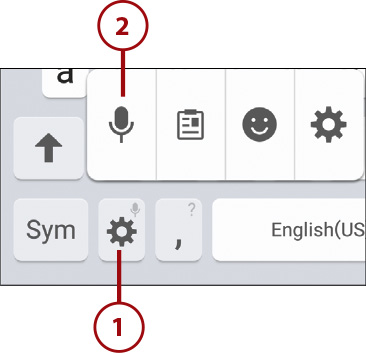
3. Wait until you see the green Microphone icon and start speaking what you want to be typed. You can speak the punctuation, for example “new line,” “question mark,” “exclamation mark,” or “period.”
4. Words that your S7 is not 100% sure of are underlined. If you see an underlined word that is not correct, tap it to change it.
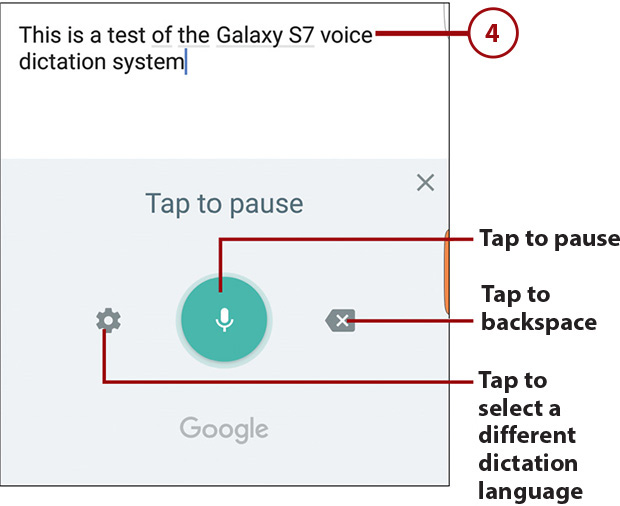
Edit Text
After you enter text, you can edit it by cutting, copying, or pasting the text. This task describes how to select and cut text so you can paste over a word with the cut text.
1. While you are typing, touch and hold a word you want to copy.
2. Slide the blue end markers until you have selected all of the text you want to copy.
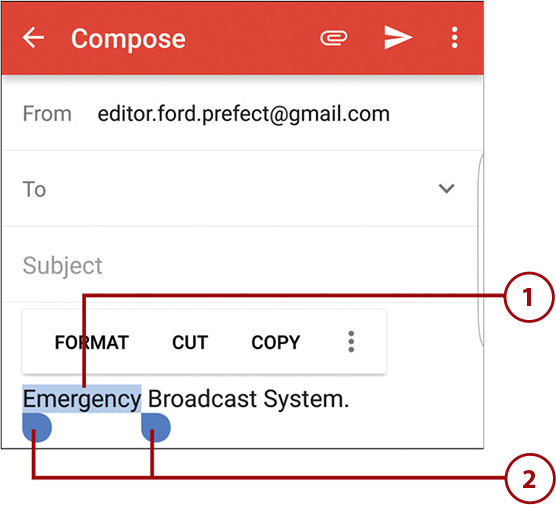

Cutting Text
Cutting text places it in the Clipboard, just like a Copy action would do.
4. Touch and hold the word you want to paste over.
5. Tap the Menu icon.

6. Tap Paste to paste what you copied over the word you have selected.
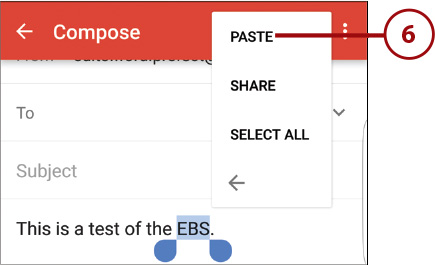
Placing a Cursor
You can also simply place a cursor on the screen and move it around to do manual text editing, such as backspacing to delete letters or manually inserting a new word. To do this, tap the screen in the text area. A single blue marker displays; drag that marker to the point in the text where you want to make changes. Start typing or tap Backspace, and the action occurs at the cursor position.
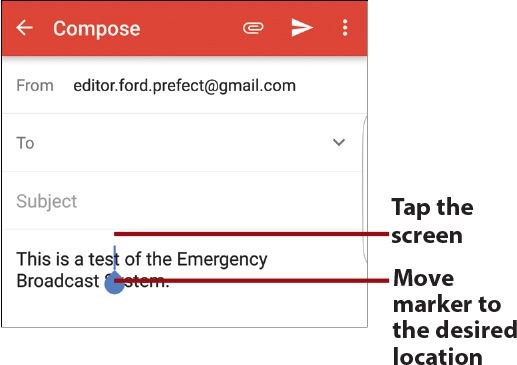
Keyboard Tricks
You can write instead of typing, use emoticons (smiley faces), and enable a one-handed keyboard.
1. Touch and hold the settings key (to the right of the Sym key).
2. Tap to use dictation.
3. Tap to see everything you have previously copied to the Clipboard. If there is text, you can touch it to paste it at the cursor position.
4. Tap to type emoticons (smiley faces).
5. Tap to change keyboard settings, including choosing a new keyboard.
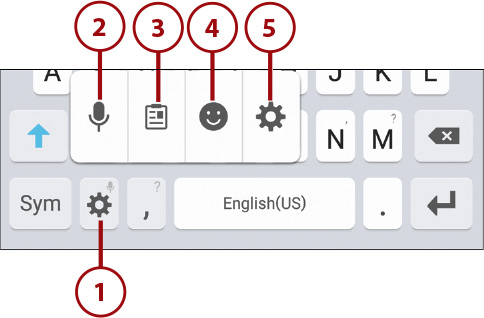
Menus
Your Galaxy S7 has two types of menus: app menus and context menus. All applications use an app menu. To see the app menu, tap the Menu icon, which is normally on the top-right of the screen. As an alternative (but slower) method, you can touch and hold the Back button to see the app menu.
A context menu applies to an item on the screen. If you touch and hold something on the screen (in this example, a button that links to a new page), a context menu appears. The items on the context menu are based on the type of object you touched.
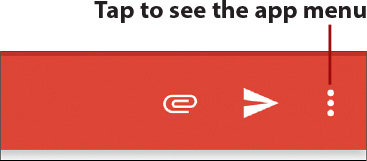
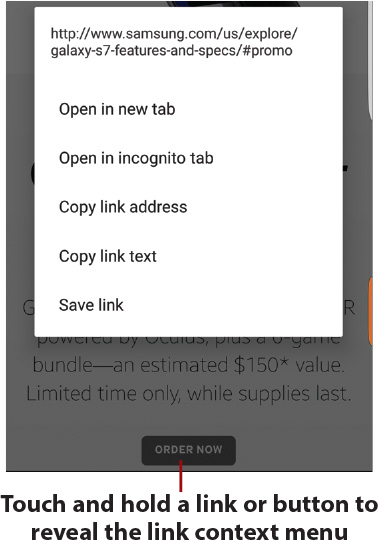
Switch Between Apps
You can switch between running apps and close apps using the multitasking feature.
1. Tap the Recent Apps button (to the left of the Home button).
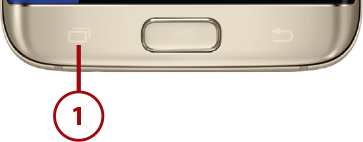
2. Scroll up and down the list of running apps.
3. Tap an app to switch to it.
4. Touch and hold an app icon to see memory and processor usage for each active app.
5. Tap to open the app in split-screen mode. This opens the app so that it only takes up the top half of the screen (not all apps support split-screen mode). See more about running multiple apps at the same time in the next section.
6. Swipe an app left or right off the screen to close it or tap the X on the top right of the app.

Run Multiple Apps on the Screen at the Same Time
Your Galaxy S7 has a feature called Multi Window that allows certain apps to run on the same screen at the same time. They can either run in a split-screen configuration, in multiple separate small windows, or a combination of both.
Two Apps Together on a Split-Screen
This section explains how to run two apps at the same time in a split-screen configuration.
1. Touch and hold the Recent Apps button while on the Home screen to see apps that support Multi Window.

2. Tap an app you want to run. The app launches in the top half of the screen.
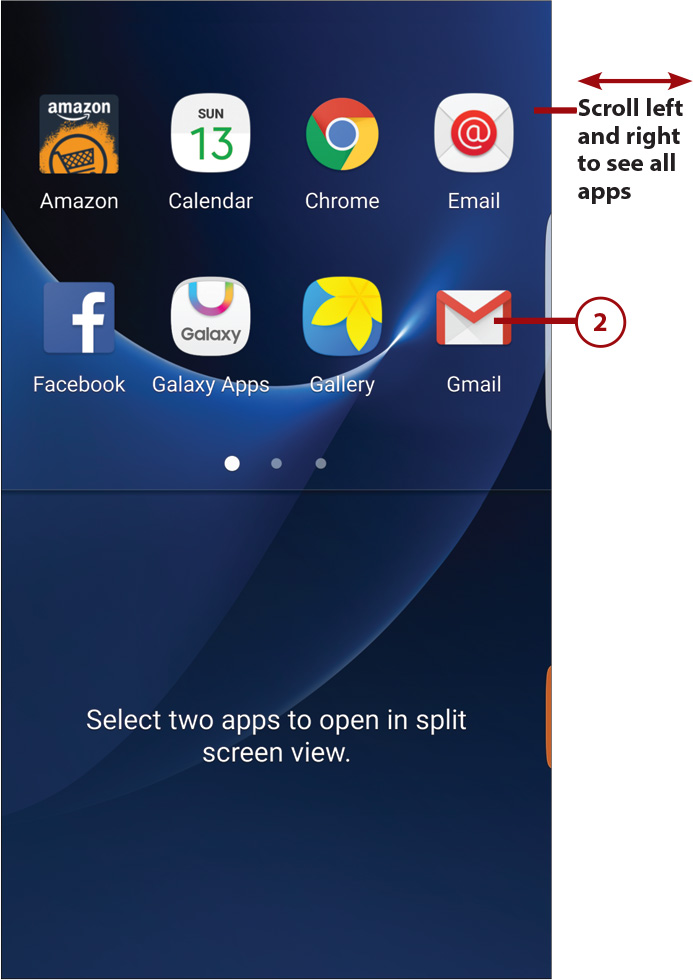
3. Tap a second app icon to launch it in the bottom half of the screen.

4. Drag the circle up or down to give more or less room to each app.
5. Tap the circle to reveal extra Multi Window features.
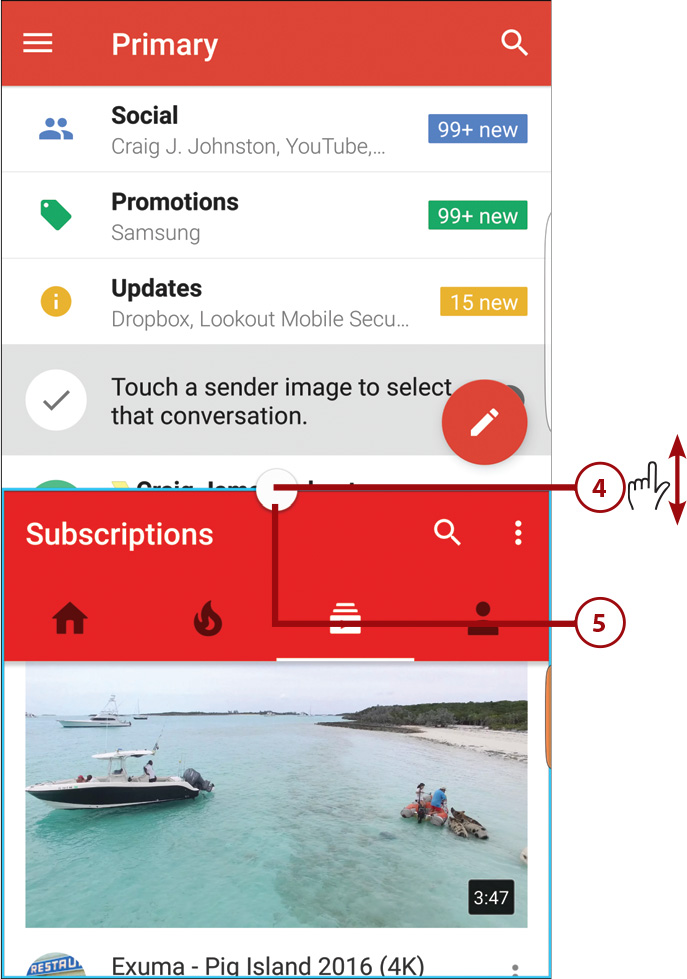
6. Tap to swap the position of the apps on the screen.
7. Tap to enable dragging content (such as text or an image) between windows.
8. Tap to minimize the selected app to a small draggable circle on the screen. A blue box indicates which is the selected app.
9. Tap to maximize the selected app to full screen. A blue box indicates which is the selected app.
10. Tap to close the app in the selected window. The selected app has a blue box around its perimeter.
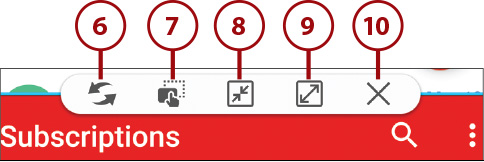
Quicker Way of Running Multi Window
If you only want to use apps that are already running in Multi Window, you can do this more quickly. Tap the Recent Apps button. Tap the Multi Window icon on any running app. That app switches to Multi Window mode and displays in the top half of the screen. Next, tap a second app to run in the bottom half of the screen. Remember that not all apps support Multi Window so some apps may not have the Multi Window icon.
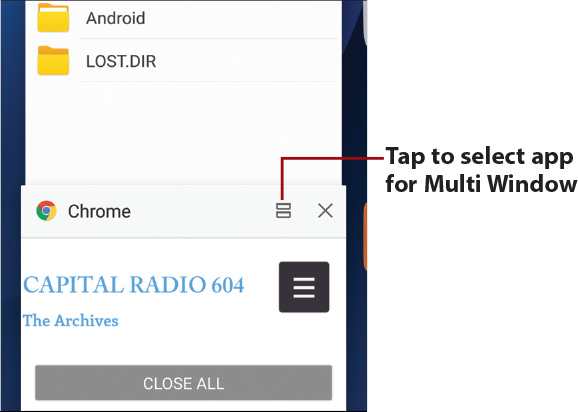
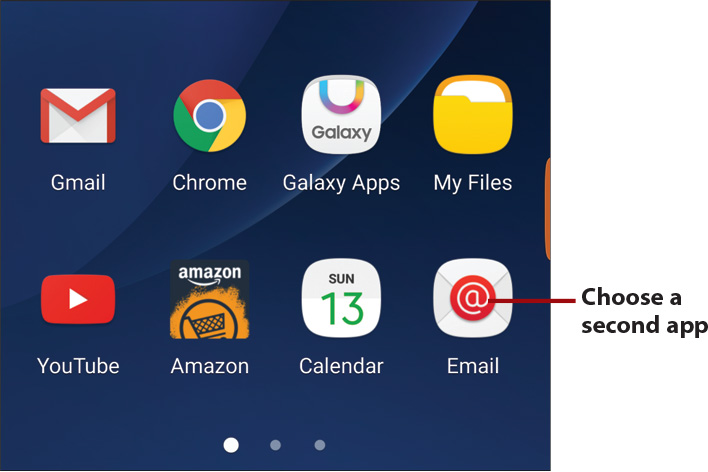
Installing Synchronization Software
Because your Galaxy S7 is tightly integrated with Google and its services, all media that you purchase from the Google Play Store on your phone is stored in the Google cloud and accessible anywhere, anytime. However, you might have a lot of music on your computer and need to copy that to your Google cloud. To do that, you need to install the Google Music Manager software or the Android File Transfer app for your Mac to copy any files back and forth.
Install Android File Transfer (Apple Mac OS X)
You only need the Android File Transfer app when using a Samsung Android phone (such as your Galaxy S7) on an Apple Mac running OS X.
1. From your Mac, browse to http://www.android.com/filetransfer/ and download the Android File Transfer app.

2. Click the Downloads icon.
3. Double-click the app in your Safari Downloads.
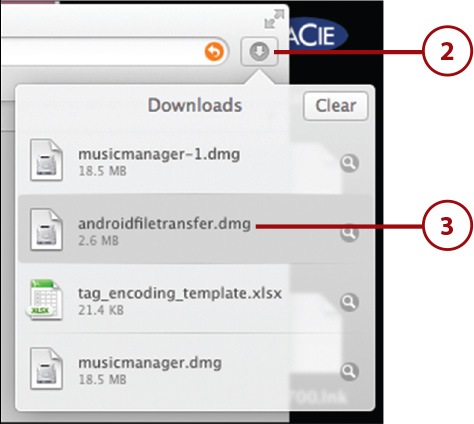
4. Drag the green Android to the Applications shortcut to install the app.
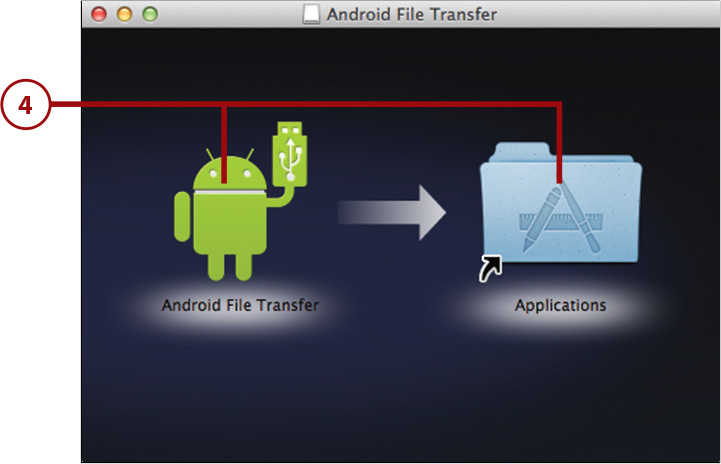
Install Google Music Manager (Apple Mac)
Don’t install Google Music Manager unless you plan to upload files from your computer to the Google cloud.
1. Visit https://music.google.com/music/listen#manager_pl from your desktop web browser and log in to your Google account if you’re prompted.
2. Click to download Music Manager.

3. Click the Downloads icon.
4. Double-click the app in your Safari Downloads.
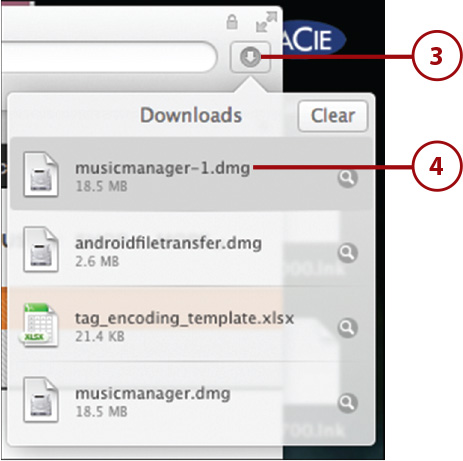
5. Drag the Music Manager icon to the Applications shortcut to install the app.
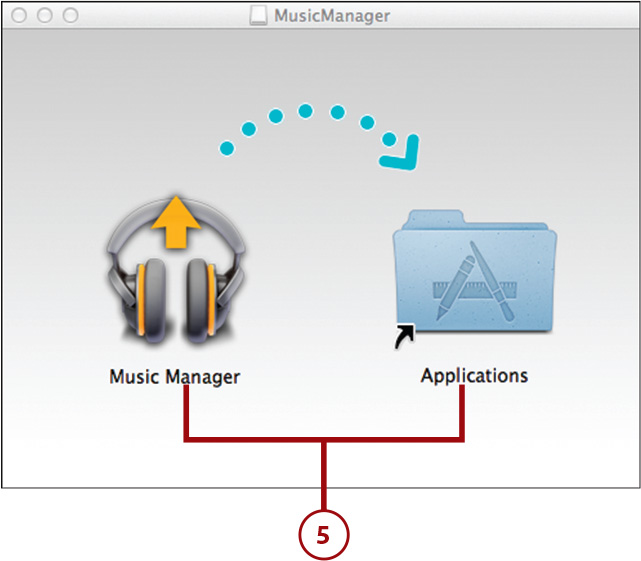
6. Double-click the Music Manager icon in the Applications folder.
7. Skip to the “Configure Music Manager” section to complete the installation.

Install Google Music Manager (Windows)
Don’t install Google Music Manager unless you plan to upload files from your computer to the Google cloud.
1. Visit https://music.google.com/music/listen#manager_pl from your desktop web browser and log in to your Google account if you’re prompted.
2. Click to download Music Manager.

3. Double-click the app in your Downloads folder.

4. Skip to the “Configure Music Manager” section to complete the installation.
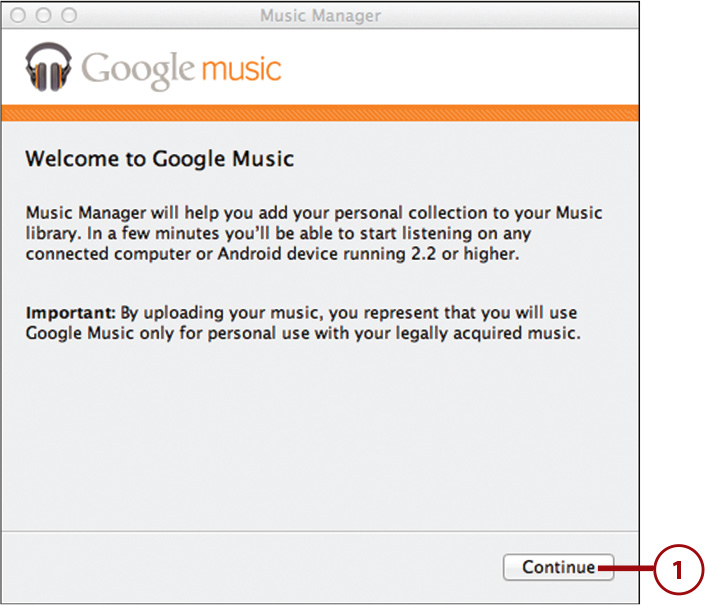
2. Enter your Google (Gmail) email address.
3. Enter your Google (Gmail) password.
4. Click Continue.
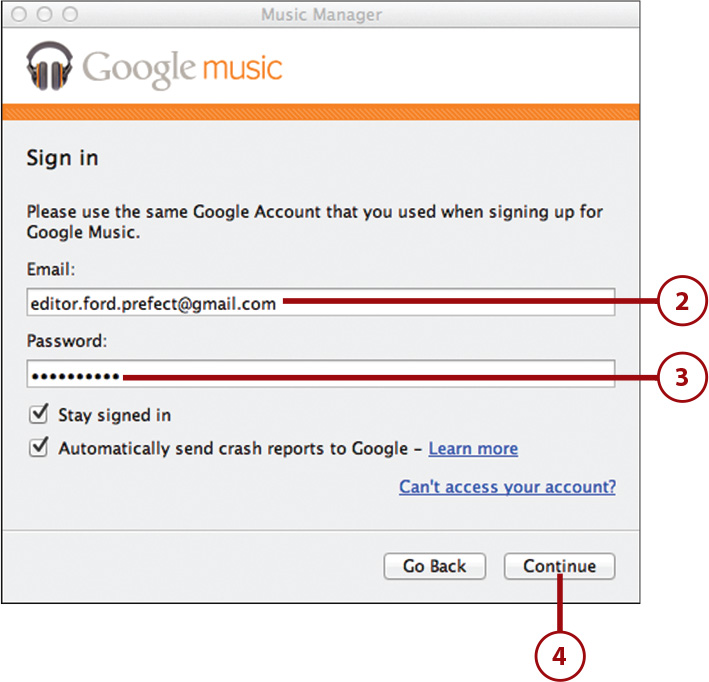
5. Choose where you keep your music.
6. Click Continue.
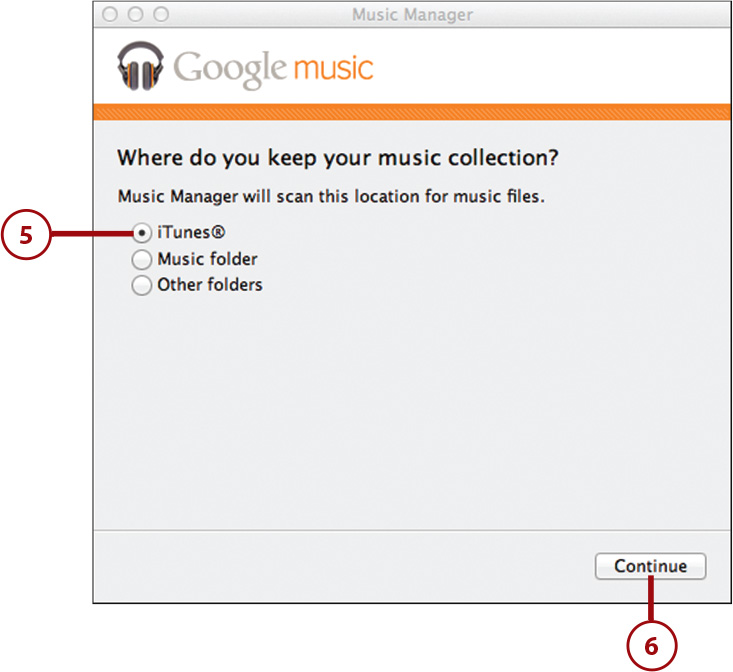
7. Choose whether to upload all of your music or just some of your playlists. Remember that you can only upload 20,000 songs for free. Skip to step 12 if you chose to upload all music.
8. Check if you also want to upload podcasts.
9. Click Continue.

10. Select one or more playlists of music.
11. Click Continue.
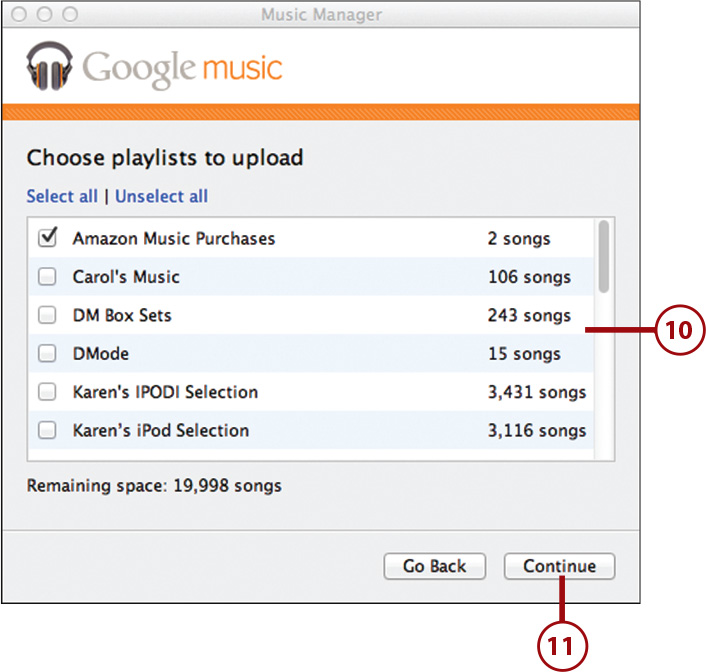
12. Choose whether you want to automatically upload any new music that is added to your computer.
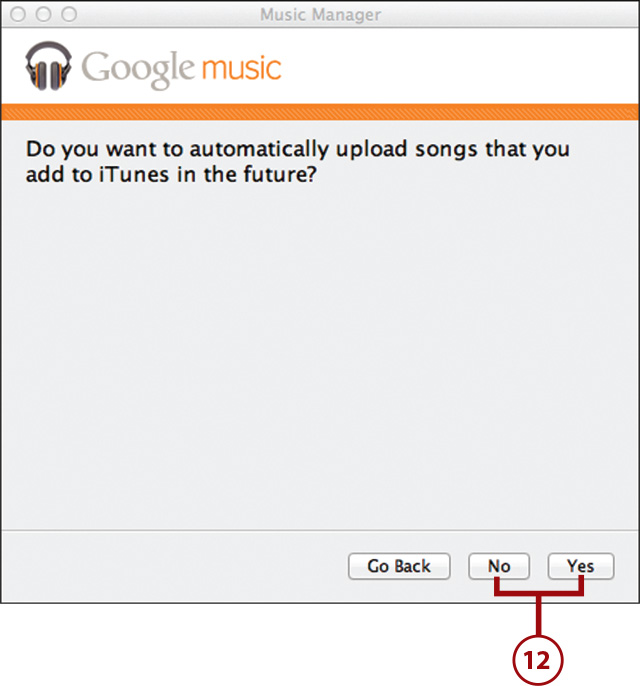
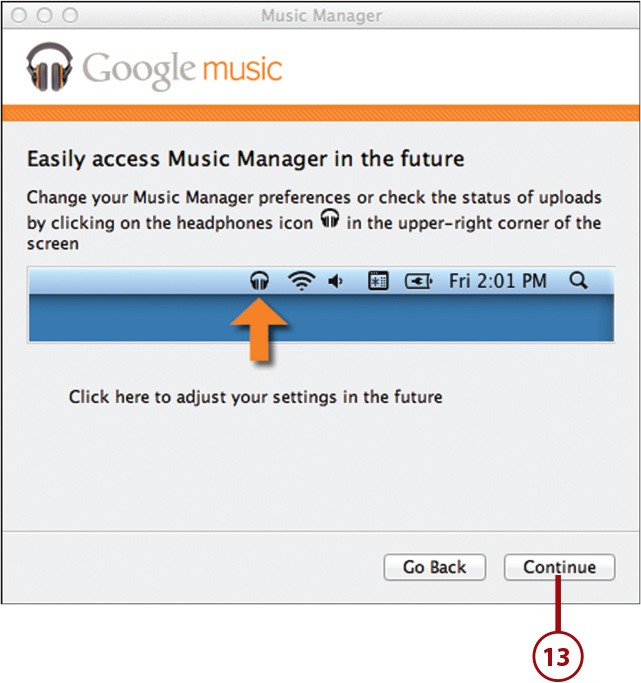
14. Click Close.


